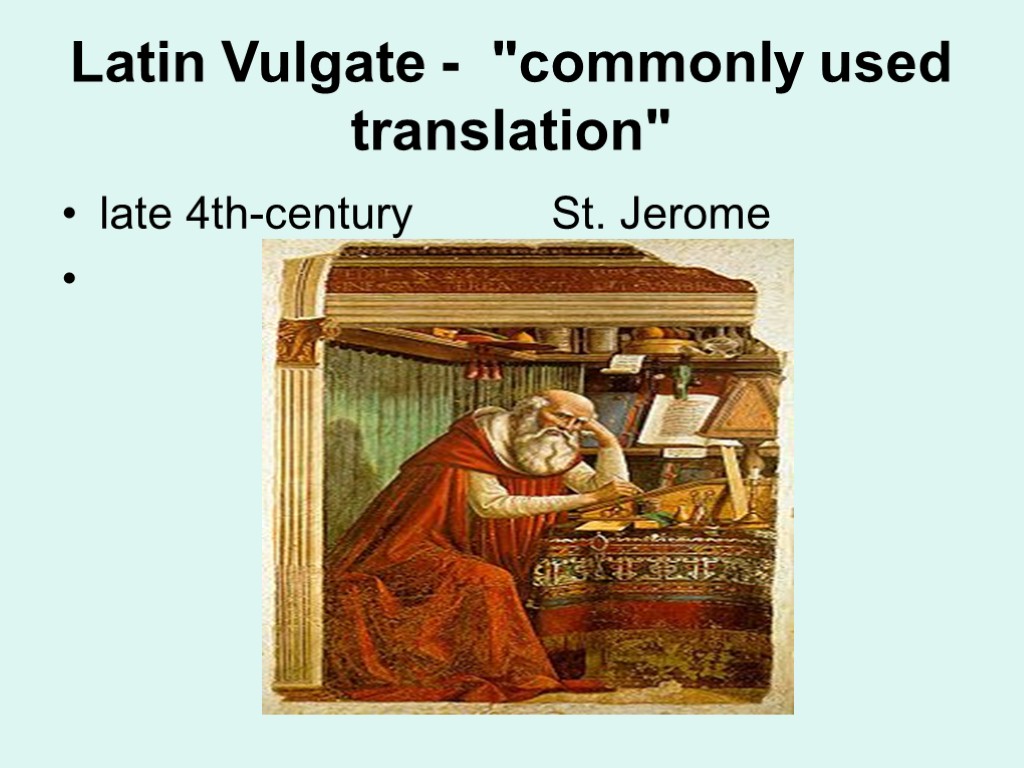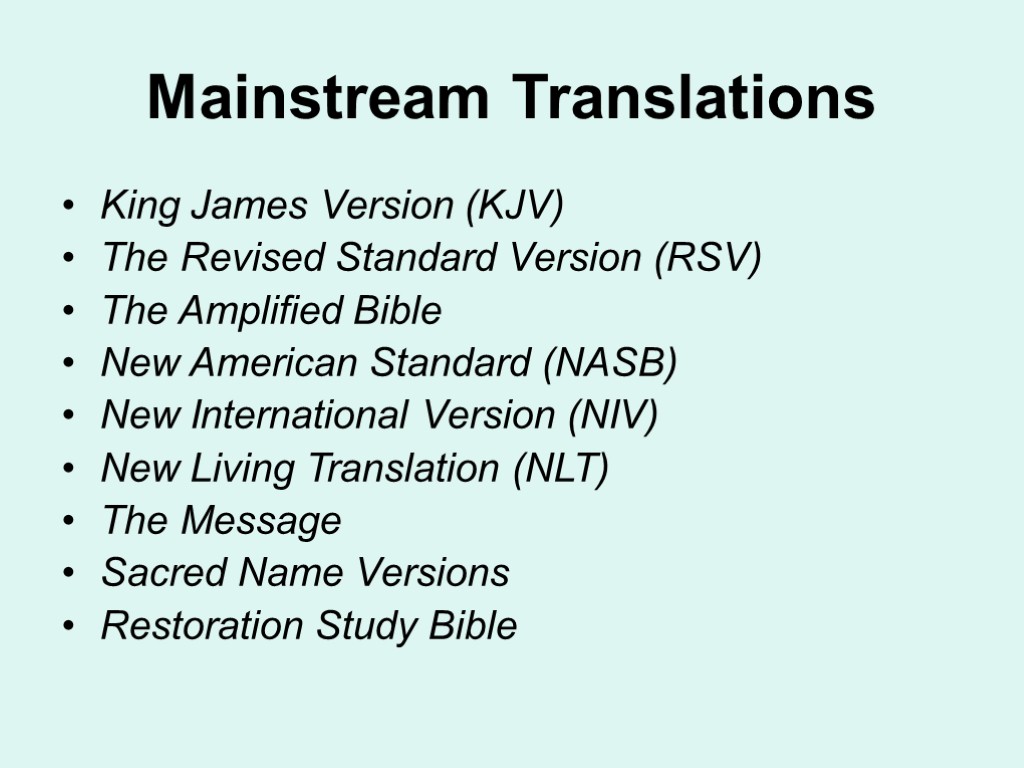TRANSLATION AND RELIGION A sacred text, its definition




















translation_and_religion.ppt
- Количество слайдов: 19
 TRANSLATION AND RELIGION A sacred text, its definition Translatability of a sacred text, dichotomy of the issue Translation difficulties and strategies. The Bible Translations Difficulties and methods of the Bible Translation
TRANSLATION AND RELIGION A sacred text, its definition Translatability of a sacred text, dichotomy of the issue Translation difficulties and strategies. The Bible Translations Difficulties and methods of the Bible Translation
 In the beginning was the word, but then the word changed. Translation has always been important in religions that seek converts. The Christian Bible has been through countless transformations in its 2000-odd year history, many of them extremely contentious. Islam, despite an orthodox insistence that the Arabic version of the Qur'an is the only authentic one, has yielded to pressure to open the text up to readers in Persian, Turkish, Tagalog and more. Outsiders have translated it into English, with controversial results.
In the beginning was the word, but then the word changed. Translation has always been important in religions that seek converts. The Christian Bible has been through countless transformations in its 2000-odd year history, many of them extremely contentious. Islam, despite an orthodox insistence that the Arabic version of the Qur'an is the only authentic one, has yielded to pressure to open the text up to readers in Persian, Turkish, Tagalog and more. Outsiders have translated it into English, with controversial results.
 The idea that translation can achieve perfect correspondence is a myth; a problem not least for those who claim to be literalists but use a version other than the original. And intellectual battles, if not wars, have been fought over ambiguities in different versions of holy texts.
The idea that translation can achieve perfect correspondence is a myth; a problem not least for those who claim to be literalists but use a version other than the original. And intellectual battles, if not wars, have been fought over ambiguities in different versions of holy texts.
 A sacred text is defined as a body of writing held to be the core or received doctrine of a religious belief system. It has been argued that a sacred text is a distinct genre, with certain defining characteristics.
A sacred text is defined as a body of writing held to be the core or received doctrine of a religious belief system. It has been argued that a sacred text is a distinct genre, with certain defining characteristics.
 Translatability of a sacred text, dichotomy of the issue 1) a sacred text may be inherently untranslatable in secular language inviolable, sacrosanct, of transcendent origin cannot ever ultimately be fully apprehended by human beings
Translatability of a sacred text, dichotomy of the issue 1) a sacred text may be inherently untranslatable in secular language inviolable, sacrosanct, of transcendent origin cannot ever ultimately be fully apprehended by human beings
 The original religious text is often identified by believers with its source language and cannot be rendered into another tongue. The Qur’an stresses its Arabic nature, Muslim scholars believe that any translation cannot be more than an approximate interpretation, intended as a tool of the study and understanding of the original Arabic text.
The original religious text is often identified by believers with its source language and cannot be rendered into another tongue. The Qur’an stresses its Arabic nature, Muslim scholars believe that any translation cannot be more than an approximate interpretation, intended as a tool of the study and understanding of the original Arabic text.
 2) exoteric - open to all believers A contradiction throughout the history of the establishment and growth of world religions: between the inviolability of canonical religious texts and the exoteric imperative to make the sacred text accessible and readily comprehensible to all.
2) exoteric - open to all believers A contradiction throughout the history of the establishment and growth of world religions: between the inviolability of canonical religious texts and the exoteric imperative to make the sacred text accessible and readily comprehensible to all.
 a dichotomy in religious translation translating in a literal way, reproducing the source text as faithfully as possible finding equivalent translations in the target language in order to fully convey their meaning, and their cultural and metaphysical referents.
a dichotomy in religious translation translating in a literal way, reproducing the source text as faithfully as possible finding equivalent translations in the target language in order to fully convey their meaning, and their cultural and metaphysical referents.
 Difficulties institutional and ideological restrictions the lack of corresponding vocabulary in the target language the lack of specific cultural connotations of words in the target text very different cultural and historical settings.
Difficulties institutional and ideological restrictions the lack of corresponding vocabulary in the target language the lack of specific cultural connotations of words in the target text very different cultural and historical settings.
 Functional translations and strategies on their own cannot be sufficient, given that textual understanding and apprehension of a sacred text can never be completely bound to epistemic truth.
Functional translations and strategies on their own cannot be sufficient, given that textual understanding and apprehension of a sacred text can never be completely bound to epistemic truth.
 THE BIBLE TRANSLATIONS the biblical languages Hebrew Aramaic Greek Jewish scholars - Masoretes Masoretic Texts
THE BIBLE TRANSLATIONS the biblical languages Hebrew Aramaic Greek Jewish scholars - Masoretes Masoretic Texts
 Greek Septuagint or LXX, or Greek Old Testament the late 2nd century BCE
Greek Septuagint or LXX, or Greek Old Testament the late 2nd century BCE
 Latin Vulgate - "commonly used translation" late 4th-century St. Jerome
Latin Vulgate - "commonly used translation" late 4th-century St. Jerome
 German Bible transted by Martin Luther (1483 –1546) the New Testament 1522 the Old Testament in 1534
German Bible transted by Martin Luther (1483 –1546) the New Testament 1522 the Old Testament in 1534
 English translations of the Bible 450 versions interlinear glosses Wyclif's Bible Tyndale’s Bible King James Version (KJV) or King James Bible (KJB)
English translations of the Bible 450 versions interlinear glosses Wyclif's Bible Tyndale’s Bible King James Version (KJV) or King James Bible (KJB)
 Difficulties in the Bible Translation
Difficulties in the Bible Translation
 Difficulties Chronological factor, copying and translating procedure no direct Lexical peculiarities of the original Stylistic peculiarities of the original
Difficulties Chronological factor, copying and translating procedure no direct Lexical peculiarities of the original Stylistic peculiarities of the original
 Methods of Translation Formal Equivalent (word-for-word) Dynamic Equivalent (thought-for-thought) Free Translation (Paraphrase)
Methods of Translation Formal Equivalent (word-for-word) Dynamic Equivalent (thought-for-thought) Free Translation (Paraphrase)
 Mainstream Translations King James Version (KJV) The Revised Standard Version (RSV) The Amplified Bible New American Standard (NASB) New International Version (NIV) New Living Translation (NLT) The Message Sacred Name Versions Restoration Study Bible
Mainstream Translations King James Version (KJV) The Revised Standard Version (RSV) The Amplified Bible New American Standard (NASB) New International Version (NIV) New Living Translation (NLT) The Message Sacred Name Versions Restoration Study Bible

